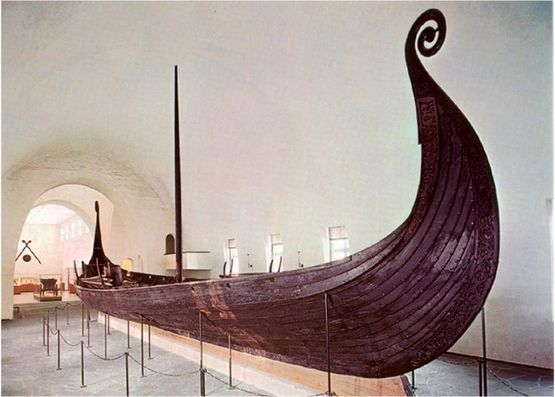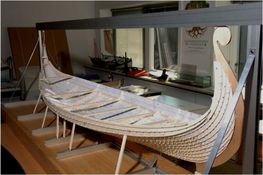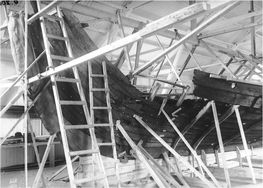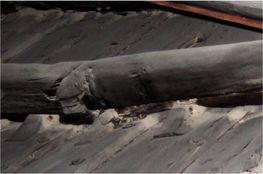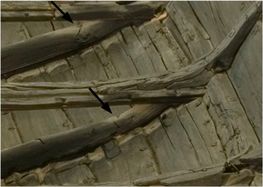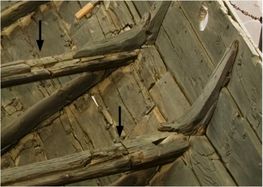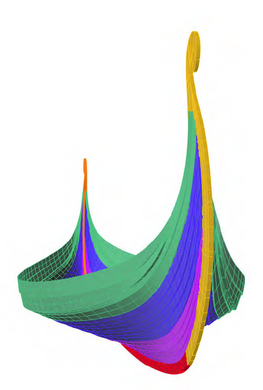New Oseberg ship, reconstruction of the hull form
The famous Norwegian Viking ship, the Oseberg ship, was built in AD 820, buried in a grave mound 14 years later, and excavated in 1904. Shortly after the excavation, the 21.5m long and 5.0m wide ship was re-assembled and exhibited at the Viking Ship Museum, in Bygdøy, Oslo. Almost 95% of the ship has survived, and in the 100 years it has been on display, it has been regarded as a faithful reconstruction. Despite the ship's unusually high-levels of preservation, when the ship was assembled and put on display, a number of decisions were made which require close examination.
In 1987, a full-scale reconstruction, 'Dronningen', was built in Norway, using drawings based on the exhibited ship. 'Dronningen' sank during its very first sea trial, which took place in windy conditions and at a speed of 8-10 knots. Analyses of the sailing trial, as well as a subsequent test of a 1:10 scale model in a hydrodynamics laboratory, showed that bow water shipped over the sheer strake when the vessel reached a speed of approximately 9 knots and a heel angle of approximately 10 degrees.
There have been many hypotheses about what went wrong. Was it the keel rocker, the shape of the bow, too small a crew, too little ballast, or too large a sail? Would the original ship have done better? The only way to find out was by thoroughly re-examining the exhibited remains. The aim of the 'Oseberg Project 2006' was to evaluate and reconstruct the hull form of the Oseberg ship anew, with the help of new methods of documentation and a reassessment and reinterpretation of the individual ship parts, based on the belief that new techniques and new expertise could provide new answers.
Recording and modelling
In 2006, the Oseberg ship was systematically photographed and both the interior and exterior of the vessel were scanned using photo and laser scanning. The outside was documented with a photo scanner, which scanned at a rate of 10 points/mm2 and with minimum 0.5 mm accuracy. The inside was scanned with a laser, scanning at a rate of 0.3 points/mm2 and with 6.0 mm accuracy.
Photo scanning is a more time-consuming process and creates larger digital files, but it is also much more detailed and accurate than laser scanning. Both scanning processes complemented each other and were a great help during the reconstruction process. On the basis of the scans, 2D drawings of all of the ship's parts were made. Cracks and deformations in the individual elements were scrutinised in order to faithfully reconstruct the original hull form. The drawings and photographs that had been made during excavation and assembly were also an invaluable source of information.
Each individual ship's part was then cut out of cardboard and assembled in a 1:10 scale model. In order to do this, the 1:10 scale drawings were printed on paper and then glued onto cardboard with the same scaled-down thickness as the ship's parts, ensuring that the planks could be assembled correctly. By creating a physical 3-D model in this way, a reliable hull form can be established. As the hull form is a coherent structure, one cannot make alterations in one dimension without influencing changes in other dimensions. If a large percentage of the ship is preserved, the model should give a reasonably precise image of the original ship's form.
Adjustments to hull form
The outside of the ship as exhibited appears smooth and coherent and shows no visible signs of irregularities. The inside of the ship, however, is more irregular, with several cracks and fragmentary pieces. The internal structure and planking also show traces of manipulation. When the ship was excavated, it was deformed and broken into ca. 2000 fragments. In the grave mound, the sides had been pressed down so that the bottom of the hull was at the same height as the sheerstrake. During the excavation, all ship parts were measured and documented before they were removed and placed in storage for 2 years. During assembly the reconstructors were understandably faced with problems, to which they applied radical solutions.
Photographs from the storage show very fragmentary, deformed and dried-out hull parts, and it is obvious that the reconstructors had a tremendous task before them. In the 1917 publication, it is noted that some parts had to be steamed up to three times in order to press them back into their original shape. A photo taken during the assembly of the ship shows that the reconstructors did not have sufficient control over the angle of the stem. The top strakes were not attached to the stem, and there were major problems in connecting the planking to that area. These problems most likely began right at the start of the reconstruction process. When the keel was excavated, it had broken into many fragments, so its rocker was unknown. When it was then installed on the exhibition frame, the angles was incorrect, causing them stem to extend too far forward. During reconstruction, they therefore experienced difficulties with the upper strakes - where the ship is broadest - which could not reach the rabbet. As a consequence of this, the reconstructors decided to press the sides of the ship inwards. In order to do this, several of the biti in the foreship were shortened.
The floor timbers were also very fragmentary. The lower edges of the floor timbers and the protruding cleats upon which they sit had collapsed. This resulted in the planks appearing up to 7 cm closer to the floor timbers than they originally were. The lines drawings used for building the full-scale reconstruction 'Dronningen' were not amended to allow for this difference.
Furthermore, the top ends of several floor timbers in the forward part of the ship were broken at the eighth strake. While putting the ship together for display, the reconstructors pressed the top ends of the floor timbers further into the ship than they would have been initially, causing the bow to be more narrow and more flat in cross-section than originally intended.
By comparing a scale drawing of an excavated floor timber with a cross-section from the laser scan of the exhibited ship, it is clear that the floor timbers were broader at the time of excavation than they appear today. This is supported by the fact that the biti in the bow seem to have been shortened, although it wasn’t possible to determine by how much. During reassembly some biti were cut or were put together from parts that seemed to fit together. The fact that several of the supports between the floor timbers and the biti stood at an angle rather than vertically - as all the other supports in the rest of the ship - supports this conclusion.
On the basis of these observations it was possible to stipulate some changes in the hull form that might be crucial for the sailing performance of the ship. Adjusting the shape of the floor timbers and reconstructing the collapsed cleats and frame edges gives the hull more fullness and lifts the stem. Correcting the shape of the floor timbers by making them wider gives the bow area a concave cross-section and more hollow lines below the bilge.
Sailing performance
After completion of the cardboard model, its dimensions were recorded. This was done with a digitising tool (Faro Arm) and the measurements were directly entered into the drafting programme Rhinoceros. On the basis of this, a 3-D lines drawing and a 3-D solid model were produced. Physical waterproof models were then made of the lines that had been used in the construction of 'Dronningen' in 1987 and of the new lines, in order to see if the sailing performance had changed after readjustment of the hull form. The models were tested in the laboratory of the Norwegian Marine Technology Research Institute (MARTINEK) in Trondheim, with different displacements, different heel angles and different leeway angles. The engineers then measured the sailing performance of the ship under conditions up to 20 knots and up to 15 degrees of heel angle and 10 degrees of drift angle.
The flow of water around the hull was remarkably different in the two scale models. The old model pressed the water to the sides rather than guiding the flow under the hull. This meant that the bow dived instead of gaining lift when speed increased. The new model created bow water that guided the flow under the hull, which made the bow lift when gaining speed. The tank tests showed two completely different ships with very different performance levels.
Conclusions
This research has led to a better insight into the original hull form of the Oseberg ship, and has provided more knowledge of the sailing capabilities of the earliest known Nordic sailing ship. The project showed that the ship originally had more fullness in the submerged part of the hull and that it has been broader above the waterline in its forward part than it appears on display today. The new reconstruction of the Oseberg ship has a more concave cross-section in the bow area with its stem lifted a little more out of the water. The reconstruction reveals that this lift gives the vessel a more rockered keel than was assumed and realised in the exhibited ship. All these factors are of vital importance for the water flow around the hull, affecting the ship’s overall sailing performance.
The corrected reconstruction of the bow shape allows the conclusion that the Oseberg reconstruction 'Dronningen' actually had less buoyancy below the bilge and a different run of the strakes in the bow than the original ship, which may have caused the bow water to ship over the sheer, which so unfortunately resulted in the sinking of the vessel in 1987. Although the new hull form was tried in a tank test, it remains to be seen if the new full-scale reconstruction which is being constructed in Tønsberg, Norway, will be a more seaworthy, more stable, and better-sailing vessel.
Vibeke Bischoff
Read the report
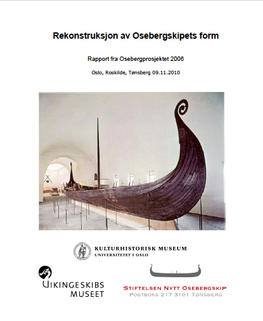
The report "Rekonstruksjon av Osebergskipets form", edited in cooperation between The Viking Ship Museum in Roskilde, The New Oseberg Ship Foundation and Museum of Cultural History in Oslo, can be downloaded here. (Norwegian only)
» Download the report "Rekonstruksjon av Osebergskipets form"... (6,9Mb)
